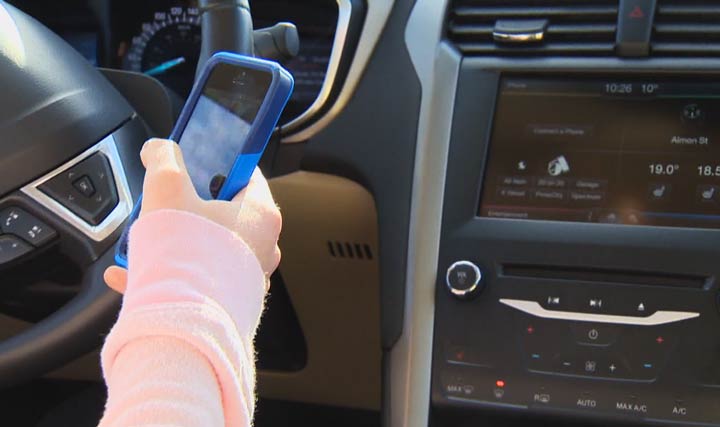Soon, it will likely cost you more than $280 if you’re caught using your cellphone behind the wheel in Saskatchewan. Minister responsible for SGI Joe Hargrave said details on the tougher penalties are coming very soon.

“I would hope to see some improvement in that right away. I mean, people have to stop,” Hargrave said.
Distracted driving is the biggest cause of injury on Saskatchewan’s roadways according to SGI, even outpacing impaired driving.
Because the end result can be the same, Premier Scott Moe said the new distracted driving penalties will be similar to impaired driving punishments at the start of the legislative session.
The tougher impaired driving penalties introduced in 2017 include an immediate three day license suspension for a first offence and fines starting at $1,250 if convicted.
“We think we’re going to end up in a spot where maybe people will start to listen, and the numbers are just going out of control,” Hargrave said.
Saskatchewan won’t be the first province to increase their penalties since distracted driving laws came into effect. Manitoba, Ontario, Quebec, British Columbia and Prince Edward Island all increased their penalties in recent years.
However, tougher penalties don’t guarantee compliance. Traffic Injury Research Foundation (TIRF) CEO Robyn Robertson said punishments are just a piece in the puzzle of deterring distracted driving.
“I think we need to keep in mind with penalties some people’s behaviour is changed by more significant penalties, but not everybody is affected by penalties,” Robertson said in a phone interview from Ottawa.
“I think we need to find alternative solutions in addition to penalties to really create that social change.”
Results in other provinces
Manitoba introduced $672 fines, a three to seven day license suspension and five demerit point punishment on Nov. 1, 2018. One year later, Manitoba Public Insurance (MPI) processed 2,592 license suspensions for distracted driving.
Prior to this, a MPI spokesperson told Global News they saw about 3,000 distracted driving convictions annually. A MPI spokesperson said they’re unable to say whether the changes are making a difference, but there may be clearer picture after five years.
Speaking to Winnipeg’s 680 CJOB earlier this month, Insp. Gord Spado with the Winnipeg police said officers are seeing more distracted drivers than are being caught.
“In Winnipeg we’re seeing about a 30 per cent drop in offence noticed issued, but I don’t that’s indicative of the acceptance of the public that this is not something they should be doing,” Spado said.
Police in Ontario are seeing a similar response. Canada’s largest province boosted fines on Jan. 1, 2019. These fines range from $615 to $3,000.
The Ontario Provincial Police (OPP) Charged 13,828 drivers with distracted driving in 2017 and 13,257 in 2018.
With the new penalties, 6,770 people have been charged year-to-date. In the same timeframe last year, 11,095 tickets were handed out.
However, an OPP spokesperson said that they aren’t sure people are getting the message. Officers are still seeing far more people on their phones while driving than are being caught.
B.C increased fines for distracted driving to $543 for a first offence and $888 for a second offence on June 1, 2016.
Insurance Corporation of British Columbia (ICBC) data shows there was a drop off in people “using an electronic device while driving.” There were about 44,000 offences in 2015. The next year, when fines increased, offences dropped to around 38,000. They climbed to 39,000 in 2017.
How to get people to hang up?
Even with distracted driving becoming increasingly expensive, drivers don’t seem to be getting the message their text message can wait.
“We are still overall seeing increases in distracted driving fatalities relative to declines in the total number of fatalities due to all different types of road safety issues, so that’s concerning,” Robertson said.
The TIRF CEO said their polling shows people appear to be complacent with distracted driving, and take more notice of other driver’s habits than their own.
“People are very focused on seeing others do it on the road, and don’t necessarily see themselves doing it, so an ‘it’s not me it’s you’ phenomenon,” Robertson said.
“That really speaks to the fact that people are not aware of the different types of distractions and able to recognize when they are actually distracted.”
This has Robertson calling for increased ways to help people recognize what distractions are, and the consequences.
SGI used a similar model when the impaired driving penalties were increased. Results the insurer said results have been positive, despite the high number of people being caught.
SGI’s traffic safety report routinely sees around 300 impaired driving offences each month. Hargrave said the province is paying for additional impaired driving enforcement, so people will get caught.
He is encouraged by decreasing impaired driving related injuries and deaths. SGI’s annual road injury and death report shows 42 impaired driving related deaths and 355 injuries in 2018. This is below the 10-year average of 57 deaths and 658 injuries.
“If people want to continue to drink and drive; police, go get’em. Get them, fine them, do what you have to do, but let’s get the deaths and injuries down,” Hargrave said.
With files from Global News Radio 680 CJOB’s Sam Thompson
Editor’s Note: An earlier version said MPI was building a five-year data set to compare the effect of old and new distracted driving penalties. A formal data set is not being built. The insurer just said five-years is an example of when there could be a better comparison.




Comments